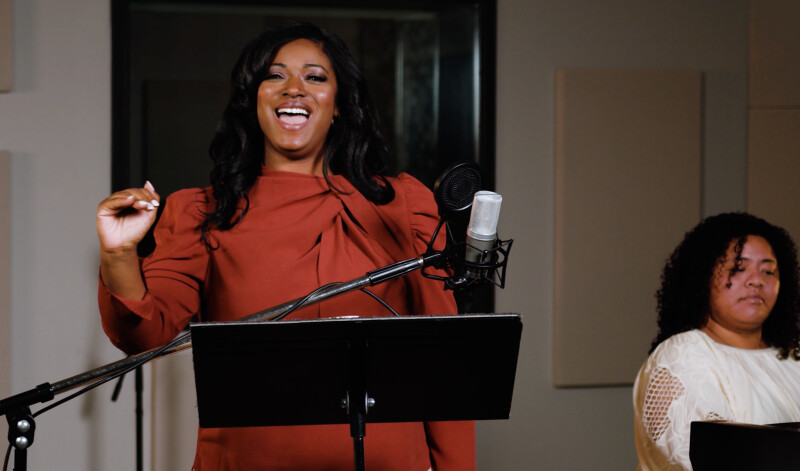In her Seek class, “Learn Singing as Worship,” Yunga Webb shares tips and exercises that can help all of us, even the most shy and reluctant singers, to sing with more joy and confidence.
As Latter-day Saints, we are a singing people with sacred hymns as a central part of our church and personal worship. There are scripture verses about singing as a form of worship in each book of the standard works, and yet many of us don’t open the hymnbook when it’s time to join in song during sacrament meeting.
The excuses are many, but perhaps the most common is, “I’m not a good singer.” Guess what? Being a good singer is not a requirement to lift your voice in praise of the Lord.
Yunga shares, “Whatever your level of comfort in singing, you can find joy, peace, and have a closer relationship with God by using your voice to worship through song.”
The second oldest child in the musical Bonner family, Yunga has been singing all her life. Her Seek class is like having a private voice lesson where she not only teaches singing techniques but also shares how to sing a joyful testimony, no matter your ability level. “Lifting our voices in song together is a way to grow our testimonies,” she says.
When we sing together, Yunga describes it as a wall of sound where “every voice adds to the choir and it is as though the Spirit is amplified.”

Yunga often finds that the hymns provide answers to her prayers and speak to her soul as she is intentional about internalizing the hymn lyrics.
One practice she has adopted is to read through the words of the hymns to be sung during the service before sacrament meeting begins.
“When you walk into the chapel and hear the prelude music, think about how music can take us to a higher spiritual level,” she says. This can also be done, Yunga teaches, by contemplating the meaning of the words of the hymns while you sing them, and by simply participating in the singing worship part of the meeting.
To sing with more confidence, one of the strategies Yunga talks about is learning how to sight-sing, meaning to sing the music as it is written to a song you’ve never seen or heard before. Sight-singing will be helpful for all of us with the release of the updated hymnbook, “Hymns—for Home and Church.” Beginning in the first half of 2024, some of the new songs planned for the hymnbook will be released digitally. A Church announcement states, “These will include well-loved music of the Church composed after 1985 (such as “Faith in Every Footstep”), music borrowed from other faiths, and some of the 17,000 new songs submitted by members of the Church.”

I look forward to singing new hymns and hymns borrowed from other faiths. As we sing these in our congregations, many of us will not be familiar with the music or words, but that doesn’t mean we shouldn’t try singing them or be afraid of hitting wrong notes when we do.
Kalo Latu, the accompanist for Yunga’s Seek course, teaches piano at BYU and often accompanies vocalists while they sight-sing.
She shared, “If you’re approaching new music, the best thing to do, especially if you are not proficient at reading music, is to listen to recordings of it.”
Use the Gospel Library app for recordings of hymns and primary songs or search for a video on YouTube. “Listen to it while you follow along with the music,” she explains, “so you know what the movement of notes is supposed to sound like.”
Since singing a new song during sacrament meeting doesn’t usually allow for listening to a piece of music first, Yunga encourages that while the organist or pianist plays the introduction to the song, to look at the music notes and listen for the melody.
To demonstrate what sight-singing is, Yunga was vulnerable and sight-sang a hymn she wasn’t familiar with for the Seek class. While she sang most of the notes correctly and all of them beautifully, there was one part where she didn’t get the interval quite right. As the producer for the class, I appreciated that she was willing to let us share what this process is like and how challenging sight-singing can be, even for an experienced singer and performer.
We can all relate to singing off-key, even if it’s just while singing along to a favorite song in the car, and Yunga shows how to carry on with the song when a note isn’t perfect. She says, “The more you practice [sight-singing] at home and the more you practice this in sacrament meeting, the better you get at it.” The worship behind the singing is what matters.
Kalo shared that one of her ward friends is tone deaf so most of the notes she sings aren’t correct but that doesn’t stop her from joining in the hymns. “I think she’s a perfect example of engaging in the worship that happens with the hymns,” Kalo says. “Just sing because it’s a form of worship and don’t worry if you’re singing the right notes or if you don’t think your voice has a pretty timbre. Engaging with the hymn in some way is being worshipful.”
No matter what your singing ability, Yunga explains, “Music is a powerful tool, and it’s a gift from our Heavenly Father that we can use to connect with Him.”
Find Yunga’s full Seek course here.


